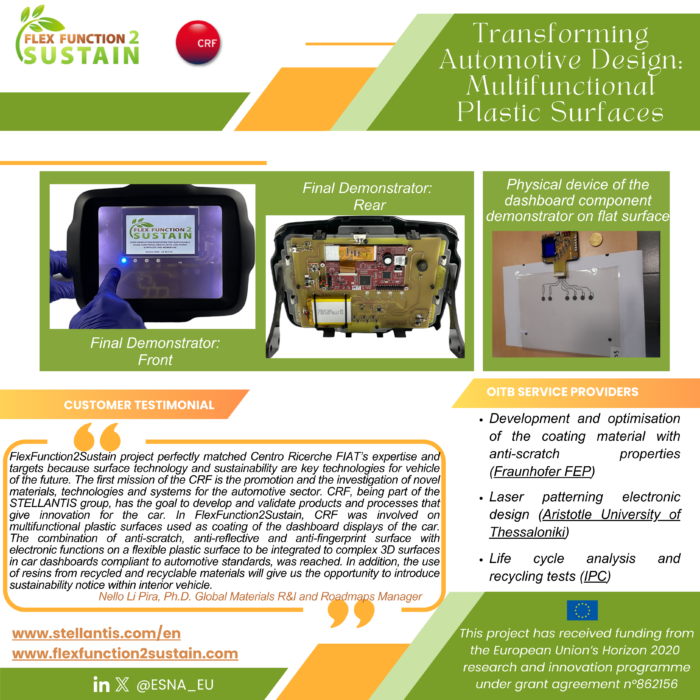Transforming Automotive Design: Multifunctional Plastic Surfaces – Fiat success story
As part of the developments carried out in the FlexFunction2Sustain project, Centro Ricerche Fiat (CRF), automotive research center in Italy within STELLANTIS group, has been focusing on its use case dedicated to improving the functional characteristics of display coatings. Together with the partners Fraunhofer Institute who assured the material to build the device with anti-scratch properties, the University of Thessaloniki who had the laser patterning facility, the Industrial Technical Center for Plastics and Composites who had the mold facility, the goal was to develop and validate the multifunctional combination of flexible electronics with scratch-resistant, anti-reflective surfaces for car dashboards or overhead consoles. The final deliverable showed the validation of a device for automotive application with the hard coat treatment, the electronic pattern laser scribed, and the molding process developed. The specification of the optical properties is defined by two methods: the scratch tests following the FIAT Standard MS90165 and the reflectance method with a spectrophotometer. The results were positive with both methods.
The solution developed consists of a demonstrator of a dashboard component on flat surface, connected with the electronic board that was developed in the project and its touch functionality successfully tested.
“FlexFunction2Sustain project perfectly matched Centro Ricerche FIAT’s expertise and targets because surface technology and sustainability are key technologies for vehicle of the future. The first mission of the CRF is the promotion and the investigation of novel materials, technologies and systems for the automotive sector. CRF, being part of the STELLANTIS group, has the goal to develop and validate products and processes that give innovation for the car. In FlexFunction2Sustain, CRF was involved on multifunctional plastic surfaces used as coating of the dashboard displays of the car. The combination of anti-scratch, anti-reflective and anti-fingerprint surface with electronic functions on a flexible plastic surface to be integrated to complex 3D surfaces in car dashboards compliant to automotive standards, was reached. In addition, the use of resins from recycled and recyclable materials will give us the opportunity to introduce sustainability notice within interior vehicle.” Says Nello Li Pira, Ph.D. Global Materials R&I and Roadmaps Manager at CRF.
Read the full story HERE.

.